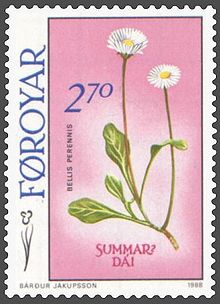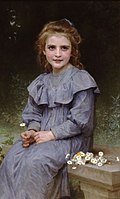Bellis perennis
| Bellis perennis | |
|---|---|

| |
| Scientific classification | |
| Kingdom: | Plantae |
| Clade: | Tracheophytes |
| Clade: | Angiosperms |
| Clade: | Eudicots |
| Clade: | Asterids |
| Order: | Asterales |
| Family: | Asteraceae |
| Genus: | Bellis |
| Species: | B. perennis
|
| Binomial name | |
| Bellis perennis | |
| Synonyms[1] | |
| |

Bellis perennis, the daisy, is a common European species of the family Asteraceae, often considered the archetypal species of that name. To distinguish this species from other "daisies" it is sometimes qualified as common daisy, lawn daisy or English daisy. Historically, it has also been widely known as bruisewort, and occasionally woundwort (although the common name "woundwort" is now more closely associated with the genus Stachys).
B. perennis is native to western, central and northern Europe, including remote islands such as the Faroe Islands but has become widely naturalised in most temperate regions, including the Americas[2][3] and Australasia.
Description[]
It is a perennial herbaceous plant with short creeping rhizomes and rosettes of small rounded or spoon-shaped leaves that are from 3/4 to 2 inches (approx. 2–5 cm) long and grow flat to the ground. The species habitually colonises lawns, and is difficult to eradicate by mowing – hence the term 'lawn daisy'. It exhibits the phenomenon of heliotropism where the flowers follow the position of the sun in the sky.
The flowerheads are composite, about 3/4 to 1-1/4 in (approx. 2–3 cm) in diameter, in the form of a pseudanthium, consisting of many sessile flowers with white ray florets (often tipped red) and yellow disc florets. Each inflorescence is borne on a single leafless stem 3/4 – 4 in (approx. 2–10 cm), rarely 6 in (approx. 15 cm) tall. The capitulum, or disc of florets, is surrounded by two rows of green bracts known as "phyllaries".[4] The achenes are without pappus.[5]
Cultivation[]
Bellis perennis generally blooms from early to midsummer, although when grown under ideal conditions, it has a very long flowering season and will even produce a few flowers in the middle of mild winters.[6][7]
It can generally be grown in USDA Zones 4 – 8 (i.e. where minimum temperatures are above −30 °F (−34 °C)) in full sun to partial shade conditions, and requires low or no maintenance. It has no known serious insect or disease problems and can generally be grown in most well-drained soils. The plant may be propagated either by seed after the last frost, or by division after flowering.[6][8]
Though not native to the United States,[9] the species is still considered a valuable ground cover in certain garden settings (e.g., as part of English or cottage inspired gardens, as well as spring meadows where low growth and some color is desired in parallel with minimal care and maintenance while helping to crowd out noxious weeds once established and naturalised).
Numerous single- and double-flowered varieties are in cultivation, producing flat or spherical blooms in a range of sizes (1 cm to 6 cm) and colours (red, pink & white). They are generally grown from seed as biennial bedding plants. They can also be purchased as plugs in Spring.
It has been reported to be mostly self-fertilizing, but some plants may be self-sterile.[10]
Etymology[]

Bellis may come from bellus, Latin for "pretty", and perennis is Latin for "everlasting".
The name "daisy" is considered a corruption of "day's eye",[11] because the whole head closes at night and opens in the morning. Chaucer called it "eye of the day". In Medieval times, Bellis perennis or the English Daisy was commonly known as "Mary's Rose".[12] It is also known as bone flower.[13]
The English Daisy is also considered to be a flower of children and innocence.[14]
Daisy is used as a girl's name and as a nickname for girls named Margaret, after the French name for the oxeye daisy, marguerite.
Uses[]
Culinary[]
This daisy may be used as a potherb. Young leaves can be eaten raw in salads[15] or cooked, noting that the leaves become increasingly astringent with age.[6] Flower buds and petals can be eaten raw in sandwiches, soups and salads.[7] It is also used as a tea and as a vitamin supplement.[2]
Herbal medicine[]
Bellis perennis has astringent properties and has been used in herbal medicine.[16]
Other uses[]
Daisies have traditionally been used for making daisy chains in children's games.[17]
Gallery[]
- Bellis perennis

Housefly on flower

Closeup view
Leaf

Flowers

Pink flower

Bud opening
- Bellis perennis in paintings

Daisies by William-Adolphe Bouguereau (1894)

The daisy chain by Maude Goodman (1936)
Possible Variations[]
- Bellis perennis var. Neo-zealandia
References[]
- ^ The source The Plant List used was the . "Bellis perennis L." The Plant List; Version 1. (published on the internet). Royal Botanic Gardens, Kew and Missouri Botanical Garden. 2010. Retrieved November 12, 2012.
- ^ a b "Bellis perennis Linnaeus". Flora of North America.
- ^ PLANTS Profile., "Bellis perennis L. lawndaisy", USDA Natural Resources Conservation Service. http://plants.usda.gov/java/profile?symbol=bepe2
- ^ Stace, C. A. (2010). New Flora of the British Isles (Third ed.). Cambridge, U.K.: Cambridge University Press. p. 749. ISBN 9780521707725.
- ^ Parnell, J. and Curtis. 2012. Webb's An Irish Flora. Cork University Press ISBN 978-1-85918-478-3
- ^ a b c "Bellis perennis L." Missouri Botanical Garden Bellis perennis.
- ^ a b "Bellis perennis L". Plants for a Future database.
- ^ "USDA Zones". USDA Plant Hardiness Zone Map. Archived from the original on 2014-02-27. Retrieved 2012-05-02.
- ^ "USDA Plants Profile for Bellis perennis (lawndaisy)". usda.gov.
- ^ WARWICK, S. I.; BRIGGS, D. (September 1979). "The Genecology of Lawn Weeds". New Phytologist. 83 (2): 509–536. doi:10.1111/j.1469-8137.1979.tb07616.x. ISSN 0028-646X.
- ^ "daisy facts, information, pictures – Encyclopedia.com articles about daisy". www.encyclopedia.com.
- ^ The Plant-Lore and Garden-Craft of Shakespeare, by Henry Nicholson Ellacombe. W. Satchell and Company, London, 1884
- ^ Nowick, Elaine (2014). Historical Common Names of Great Plains Plants, with Scientific Names Index: Volume II: Scientific Names Index. Lulu.com. p. 66. ISBN 978-1-60962-060-8.
- ^ "Daisy." The Columbia Encyclopedia, 6th ed., 2011. Encyclopedia.com
- ^ Johanna Budwig, Krebs – ein Fettproblem, richtige Wahl und Verwendung der Fette. Hyperion-Verlag, Freiburg im Breisgau 1956, p. 44: recipe for cancer patients.
- ^ Howard, Michael. Traditional Folk Remedies (Century, 1987), p129
- ^ "Children's 'right to play'". BBC News. BBC. 2002-08-07. Retrieved 2008-11-02.
External links[]
| Wikimedia Commons has media related to Bellis perennis. |
| Wikiquote has quotations related to: Daisies |
| Wikispecies has information related to Bellis perennis. |
- Astereae
- Garden plants
- Medicinal plants of Europe
- Perennial plants
- Plants described in 1753
- Taxa named by Carl Linnaeus







